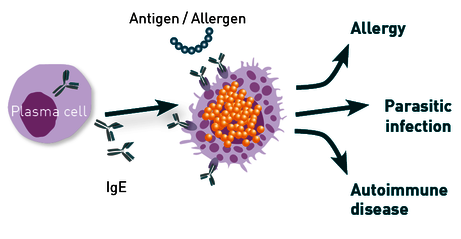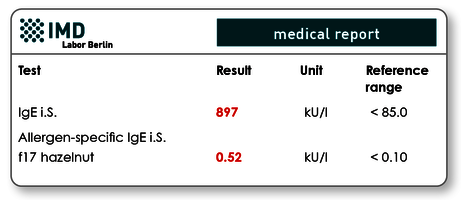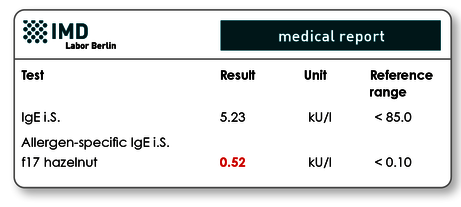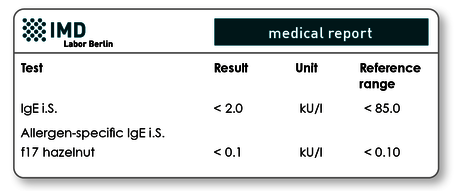Total IgE – What does this laboratory parameter signify?
Immunoglobulin E (IgE) is an antibody primarily associated with its key role in type I allergic reactions, such as hay fever or allergic asthma. However, its actual physiological task in the human body is the defense against parasites.
What is immunoglobulin E (IgE)?
Like other classes of antibodies, immunoglobulin E (IgE) is synthesised by plasma cells. Its main function is the defence against parasitic infections (e.g. helminths and protozoa). Although IgE is found free in the serum in the body, it is mainly bound to receptors on the surface of mast cells and eosinophilic and basophilic granulocytes. Binding of appropriate antigens to these cell surface-bound IgE antibodies results in the release of histamine, leukotrienes, prostaglandins and various other pro-inflammatory mediators. In an allergy, IgE antibodies erroneously target actually harmless substances from our environment (e.g. pollen, foodstuff). However, in certain autoimmune diseases (e.g. urticaria), these antibodies can also target the body's own proteins. This explains the often similar clinical symptoms of inflammation (skin rash, anaphylaxis) (Fig. 1).

Fig. 1 Cell-bound IgE antibodies recognise specific antigens and thus play a role in the fight against parasitic infections, but also in allergies and autoimmune diseases.
Significance of total IgE in allergy diagnostics
Total serum IgE is hardly relevant for the verification or exclusion of a type I allergy. Total IgE is not a screening parameter for type I allergies. Clinical experience allows only
a very crude association (Fig. 2).
| CHILDREN | |
|---|---|
| Age | Normal range |
| Umbilical cord blood | up to 0.70 kU/l |
| 0 - 0.5 years | up to 2.75 kU/l |
| 0.5 - 2 years | up to 3.75 kU/l |
| 2 - 5 years | up to 16.0 kU/l |
| 5 - 8 years | up to 26.2 kU/l |
| 8 - 12 years | up to 34.6 kU/l |
| 12 - 16 years | up to 26.3 kU/l |
| ADULTS | |
|---|---|
| Total IgE level | Assessment |
| < 20 kU/l | Allergy unlikely |
| 20 - 100 kU/l | Allergy possible |
| > 100 kU/l | Allergy likely |
Fig. 2 Total IgE is not an allergy screening parameter, but provides only a rough indication
So when is the total IgE important?
In allergological questions, the specific IgE against the suspected trigger should always be determined. However, the parallel examination of total IgE is useful, as it enables an optimised assessment of the results. A specific IgE is likely to be of clinical relevance, if it accounts for more than 1% of the total IgE.
In some cases, patients may possess little or no free IgE. This does not rule out an allergy, since the clinical symptoms are, as described above, not mediated by free, but by cellbound IgE antibodies. In these patients, IgE diagnostics has no informative value and allergy diagnostics using a basophil degranulation test is recommended as an alternative (Fig. 3C). In addition, a higher relevance is assigned to specific IgE in patients with low total IgE levels than in patients with high total IgE (Fig. 3A and B).

A - clinical relevance of hazelnut sensitisation unlikely

B - clinical relevance of hazelnut sensitisation likely

C - Specific IgE result cannot be evaluated
Fig. 3 Total IgE supports the assessment of allergy diagnostic findings
Significance of total IgE in further clinical questions
Significance of elevated total IgE
Upon exclusion of an allergy, an elevated total IgE can indicate, on the one hand, a parasitic infection, e.g. worm infestation (helminthiasis) or infections with roundworms, tapeworms or threadworms, and, on the other hand, autoimmune disorders or immunodeficiencies. Possible differential diagnoses are listed in Table 1.
Significance of decreased total IgE
The prevalence of undetectable total IgE (<2.0 kU/l) in the total population is approx. 3%. Undetectable or very low IgE levels may indicate an immunodeficiency or bone marrow disease. For example, 76% of patients with variable immunodeficiency exhibit IgE deficiency. If total IgE cannot be detected, additional immunodeficiency diagnostics (differential blood count, IgA, IgM, IgG, IgG subclasses, complement tests AP50, CH50, MBL) are therefore always recommended.
| Type I allergy | Parasitosis | Other associated diseases | |
|---|---|---|---|
| Elevated total IgE | In connection with spec. IgE: Asthma or allergic rhinitis: Allergic bronchopulmonary aspergillosis: | Potential parasites: protozoa & helminths The total IgE drops, if therapy is successful. (e.g. ascariasis, schistosomiasis, strongyloidiasis, geohelminthiasis, trichuriasis, enterobiasis) | Atopic dermatitis: Spec. IgE against allergens of the skin flora possible (e.g. Malassezia, Staphyloccocus) Immunodeficiencies: Hyper-IgE syndrome, Wiskott-Aldrich syndrome, IPEX syndrome, Omenn syndrome, atypical DiGeorge syndrome, HIV Chronic spontaneous urticaria: Spec. IgE against auto-antigens Autoimmune diseases: systemic lupus, bullous pemphigoid, pemphigus vulgaris, autoimmune uveitis, rheumatoid arthritis, multiple sclerosis, autoimmune pancreatitis IgG4-associated diseases Granulomatous inflammation: Eosinophilic granulomatosis with polyangiitis (Churg-Strauss) Granulomatosis with polyangiitis (Wegener) Sarcoidosis Cancer diseases: IgE myeloma Hypereosinophilic syndrome Lymphoma Slightly elevated IgE is occasionally also found in healthy people (e.g. due to increased alcohol consumption) |
| Decreased total IgE (< 2.5 kU/l) | False-negative results in specific IgE diagnostics or prick test possible Allergy cannot be ruled out a prior | Potentially elevated risk of parasitic infections | Variable immunodeficiency Increased risk of malignancies |
Material
Total IgE: 1 ml of whole blood for serum collection
Literature
- Lawrence et al. Low Serum IgE Is a Sensitive and Specifi c Marker for Common Variable Immunodefi ciency (CVID) (2018) J Clin Immunol 38
- Ferastraoaru et al. AllergoOncology: ultra-low IgE, a potential novel bio- marker in cancer-a Position Paper of the European Academy of Allergy and Clinical Immunology (EAACI) (2020) Clin Transl Allergy 10
- Lomholt et al. High alcohol consumption causes high IgE levels but not high risk of allergic disease. (2016) JACI 138
